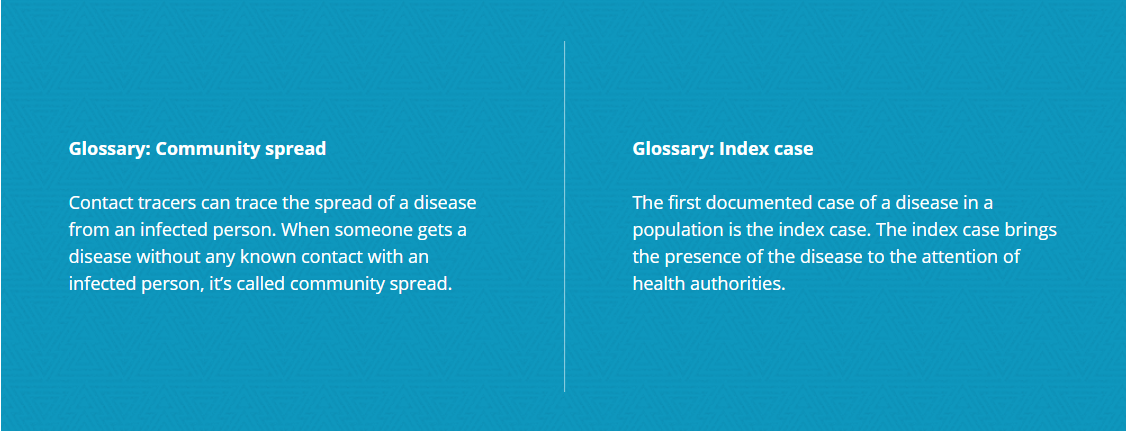Disease detectives: In a public health crisis, contact tracers are on the case
Nov. 2, 2020
In 20 July 2014, a Liberian-American man collapsed in an airport in Lagos, Nigeria, a city of more than 10 million people. Three days later, he was diagnosed with Ebola, the country’s first case. The arrival of the Ebola virus in one of the world’s largest cities was a scenario that, as one U.S. official noted at the time, generated worries of an “apocalyptic urban outbreak.”
But what could have been a ghastly epidemic was averted; only 19 additional people in Nigeria contracted the disease, and seven died. The World Health Organization (WHO) declared the country free of Ebola on 20 October, three months after that first case was diagnosed.
To achieve that, the work of the Rotary-supported polio eradication program — the strong partnerships that had been built between the Nigerian government and other organizations, as well as the infrastructure that had been put in place — proved to be key. The Nigerian health ministry swiftly declared Ebola an emergency and created a command center, modeled after those used by the polio program, to coordinate its response. A team of 40 doctors trained in epidemiology who assisted in the country’s polio eradication campaign were reassigned to tackle Ebola. Technical experts from the polio program trained health workers on contact tracing, case management, and more.
From that first patient, called the “index case,” health workers generated a list of nearly 900 contacts, diligently tracked down by a team of 150 contact tracers who conducted 18,500 face-to-face visits to check for symptoms of Ebola. Only one contact was lost to follow-up. Shoe-leather public health detective work had stopped the outbreak.

The history of contact tracing
Contact tracing has been in the news lately because of the important role it can play in slowing the spread of the novel coronavirus, but it has been a cornerstone of public health for much of the past century. In 1937, then-U.S. Surgeon General Thomas Parran wrote a book about syphilis control (melodramatically titled Shadow on the Land), in which he described contact tracing in detail. The practice has been a valuable tool ever since — for combating the spread of sexually transmitted infections as well as vaccine-preventable diseases such as measles and tuberculosis. Smallpox was defeated not by vaccinating entire populations, but by finding and vaccinating anyone who had been in contact with people who had the disease. Contact tracing has also played a part in the progress we’ve made against polio.
Regardless of the disease in question, contact tracing is based on the same premise: quickly identifying and monitoring people who have been in contact with an infected person in order to diagnose and treat them if they develop the disease — and to prevent it from spreading further, whether through vaccination or isolation. (The word “quarantine” dates back to the Middle Ages, when sailors had to remain aboard docked ships for a 40-day period — in Latin, a quarentena — to prevent the spread of bubonic plague.) Contact tracing allows health workers to find people who have been in contact with a carrier, to determine whether they are also infected, to offer support and treatment, and to build a list of that person’s contacts in case the tracing chain needs to expand.
What varies from disease to disease is who is considered a contact. Investigators look at the characteristics of the disease and how it spreads to determine who is at greatest risk of infection. Ebola, for example, is contracted through exposure to bodily fluids, so contact tracers monitored people who had had direct physical contact with an infected person — who shared meals with them, cared for them, did their laundry, or prepared their body for burial. With COVID-19, a respiratory disease, U.S. health authorities have defined a close contact as someone who was within 6 feet of an infected person for at least 15 minutes.
Some diseases, such as influenza, spread so rapidly that it’s difficult to keep up, says William Schaffner, a professor of preventive medicine and infectious disease at Vanderbilt University Medical Center. “It’s one of the difficulties we’re having with COVID-19 today.”
Another challenge in tracing the coronavirus, one that it shares with polio, is that many infected people are asymptomatic. “That very characteristic of polio baffled public health people for ages,” Schaffner says. “Before it was discovered to be an intestinal virus, they couldn’t figure out how it was spread. Some cases didn’t have any contact with each other.”
In the United States, health departments generally maintain a small staff of contact tracers; those teams are being expanded to trace the spread of COVID-19. San Francisco, for example, had only 10 people regularly working on contact tracing. The city reassigned other public employees whose workloads had lightened because of the pandemic to act as contact tracers — staff in “the city attorney’s office, assessor’s office, and, my favorite, all the city librarians,” says George Rutherford, a professor of epidemiology at the University of California at San Francisco and principal investigator on California’s contact tracing training program. Rutherford and his team were asked to train 10,000 civil servants online throughout the state. During a 20-minute interview with Rotary, he received 60 emails about it. “You can get an idea of the volume I’m dealing with,” he remarked.
Who makes an ideal contact tracer?
In New Zealand, Denise Garcia, a member of the Rotary Club of Tawa, was one of 190 contact tracers employed by the country’s Ministry of Health in the early phase of the COVID-19 pandemic. As a health professional, she was sought out to do the work. “They wanted people who could interview people and give advice,” she says. And her regular job as a midwife was deemed essential — “you can’t weigh a baby online,” she says — so she did both.
Like Garcia, the ideal contact tracer has strong interpersonal skills. One of the biggest challenges of the job, which is part detective and part social worker, is gaining people’s confidence. “They have to convincingly communicate trust,” Schaffner says. “Confidentiality is very important.” It can be especially challenging because of the social stigma of some illnesses and the mistrust in government by some groups of people. “People are wary of government intrusion, particularly at a time of turbulence — which there always is when there is a disease outbreak,” he says. “You have to come with a smile and a helping hand. But you have to get in the door.”

When Garcia would arrive at the health ministry offices after her midwifery work in the morning, she would receive a list of people to call. “Trying to contact people was the hardest thing,” she says. “It’s an unknown number; a lot of people wouldn’t answer.” And the contact tracers themselves never knew where they were calling — it could be a person on the other side of the world who had been on a flight with someone who had tested positive for the virus.
Once in touch with a person, Garcia says, she would inform them that they had been in contact with someone who had tested positive for COVID-19. She would ask them if they were well. She would confirm the contact date and talk about the need to isolate for two weeks, and ask whether the person needed to be tested or had already been tested. She would try to work out who else they had been in contact with and pass that information on to the health ministry. And she would refer them to social service agencies if they faced problems with access to food, medication, or money during their isolation period. “It was a privilege to ring people and talk to them and make sure they’re OK,” Garcia says. “You felt quite good knowing people were doing all right or that you could help them.”
The contact tracers were never given the name of the person who had the positive test. That confidentiality helps build trust — if the person contacted never discovers who was the source of their infection, they can have faith that their own name won’t be revealed, either.
Schaffner recalls working as a disease detective through what is now the U.S. Centers for Disease Control and Prevention early in his career. He remembers the man who was head of the sexually transmitted disease division at the Rhode Island Department of Health personally hauling paper records from closed cases down to the basement furnace and watching them burn. “Decades later, that is still imprinted in my brain about how sacred the confidentiality of public health records is,” he says.

Rosemary Onyibe knows about the importance of trust in tackling a disease. On 27 February, the Nigerian government announced its first confirmed case of COVID-19, and later that day, Onyibe, a public health physician who has been working with WHO in Nigeria on the polio eradication initiative since 2000, was invited by WHO to assist in the country’s response to the novel coronavirus. The infrastructure set up through the polio program would once again be invaluable.
The polio eradication effort has, over time, put in place a vast grassroots surveillance network by training more than 50,000 community members in Nigeria to look for children with acute flaccid paralysis (a sudden weakness in the limbs), the primary symptom of polio. These “community informants” — which include traditional leaders, birth attendants, healers, religious leaders, pharmaceutical vendors called chemists, members of youth groups, and other influential members of the community — watch for people showing symptoms of diseases of public health concern, including measles, tuberculosis, whooping cough, and meningitis, and report what they see to disease surveillance officers.
“These are people who are part of the community, live and work in the community, and in most cases, are selected by the community to be their reference points for health-related issues,” Onyibe says. “They have the trust of the people, who are likely to freely communicate whatever health conditions they have. They aren’t some strangers’ faces they’ve never seen before.”
Because of general suspicion of the government, Onyibe says, many Nigerians don’t think COVID-19 is real — which makes this trusted network all the more needed. Using posters and presentations, local governments trained the community informants about the symptoms of the virus, and at health facilities, WHO also supported the training of health workers to look for COVID-19. “The polio initiative has helped us train a lot of people who are now versed in disease surveillance,” Onyibe says. “We are not starting fresh. When COVID-19 hit, we didn’t need to do any serious training of our surveillance teams at the state level. We repurposed them. It was an easy transition.”
With COVID-19, community informants or health workers who identify a suspected case report it to the state, which deploys a rapid response team to take samples to test the person (though laboratory capacity has hindered testing rates). If the result is positive, the person is evacuated to an isolation center and their contacts are traced and monitored for at least 14 days. If one of them shows symptoms, that person is tested as well and the process begins again.
“The polio structure in Nigeria has made the response to any disease outbreak quicker and more focused. Because we have people who are already knowledgeable from the grassroots to the national level, we can quickly equip them to respond,” Onyibe says. “That was why Nigeria was able to defeat Ebola, and why Nigeria is also able to fight COVID-19. The world has Rotary International to thank for this.”
• This story originally appeared in the October 2020 issue of Rotary magazine.
